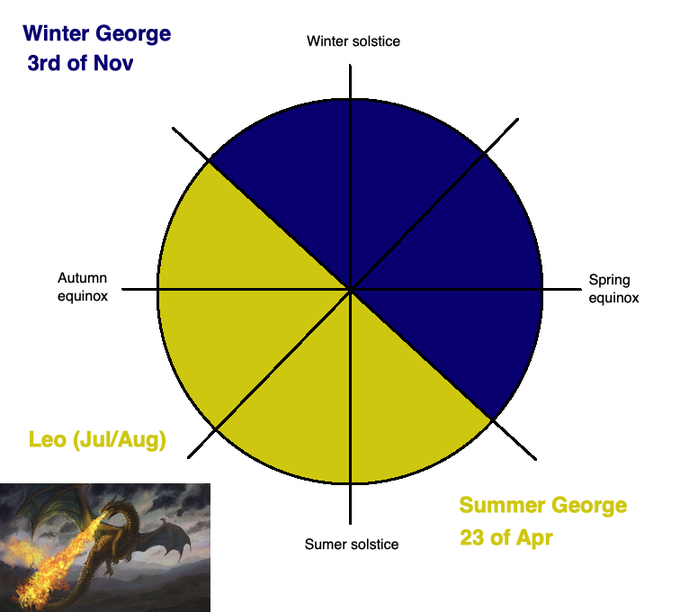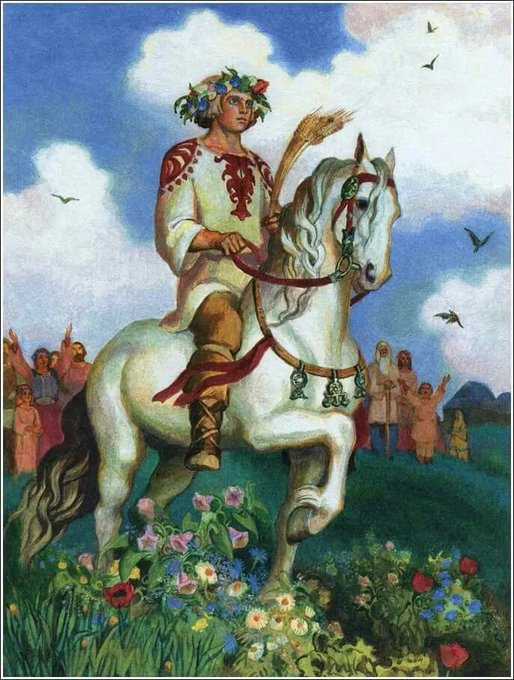St George of the Sprouting Crown. Ethiopia, 19th c
What does this mean? Let me try to explain...
I'll start with the excerpt from my post "Letnitsa treasure":
Snakes are solar animals. They are in our world when sun is in our world (hot part of the year) and they are in the underworld when sun is in the underworld (cold part of the year)...I talked about this in my post "The chthonic animal"
Snakes are symbol of the sun and the sun's heat. They are also symbols of the beginning of summer, as vipers, the most common Eurasian snakes, start mating in Apr/May, beginning of summer...
And dragons, old snakes, are symbol of the old sun, destructive summer sun which burns the land and causes drought. Steals and guards water...Which is why in Slavic mythology, dragon, always breathes fire...
And which is why in the past, during spring droughts, Serbs used to go to mountain lakes, on St George's day, and pray for rain on lake shores "to the dragons living in the lake who swallowed the rain"...
I talked about this in my post "Dragon who stole rain"...
There is actually a Serbian belief that "a snake got wings when it lived over 100 years, after which it flew away to live in lakes and waters"...Just like a Dragon...
This is in addition to the belief from Ukraine and Poland that snakes once had wings and flew in the sky. But the sun burned their wings and they fell on the ground. I wrote about this in my article about Slavic belief in the link between snakes and sun...
Now, there is an interesting Slavic word "jar" which means young, green, spring...It is the root of the name of the Slavic sun god, Jarilo (pronounced Yahreeloh)...He is the life giving spring and early summer sun that brings back life to the frozen earth...Here is a depiction of Jarilo painted by Russian artist Andrey Shishkin...
Jarilo is the original Green Man...This is Zeleni Jura (Green Jarilo) walking the earth. Part of Jurjevanje, celebration of the spring return of Jarilo, Sun god, from the land of the dead...Bela Krajina, area inhabited by descendants of Serbians who migrated here during Turkish invasions of the Balkans. Today split between Croatia/Slovenia...
But the root "jar" can also mean "brightly burning" and "raging, furious"...
This means that Jarilo can also mean "The Scorcher", the life destroying burning sun of the late summer and early autumn...
Two suns, young and old, the life creator and life destroyer...In one...
Jurjevo, the celebration of the return of Jarilo, is today known as St George's day. St George is basically Christianised Jarilo...
Jurjevo is the celebration of the beginning of the summer, the domain of the sun...And dragons...Because as the summer goes on, and the sun gets hotter and hotter, snake, the symbol of sun's heat, grows older and older and eventually turns into dragon, the symbol of destructive sun's heat...
Jarilo, The Scorcher, The Dragon...To whom Serbs, sacrificed rams during droughts, on St George's day, with blood poured into the lake, for the dragon who stole rain...
Funny...
St George = Jarilo = Dragon...
By the way, Serbs believed that the Snake King, who is "An Old Male snake", The Dragon, also had a "green branch in his mouth"...
Interesting right?
Snake King = Dragon = Jarilo = Green man...
By the way, the dragons who steal princesses in the Balkan fairytales usually live in palaces...They are kings...Snake kings...
I believe that Jurjevo, Jarilo's day, is at the same time the celebration of good spring sun and bad summer sun. The day of thanks for the spring and prayers for the summer...Anyway, on that day spring ends, summer begins...
And every year, on The Day of Jarilo, The Day of Dragon, the Young Spring Earth, Vesna, is "sacrificed" to the Young Sun, Jarilo (The Dragon). Spring (the princess) is "sacrificed" (it ends) so that Summer (The Dragon) can begin???
But wait, St George is a dragon killer!!! Well, what's the best way to Christianise Jarilo, The Sun, The Scorcher, The Dragon, than to turn it into it's opposite...The Dragon Killer...
In Serbian Orthodox church tradition, the beginning and the end of the "Time of Dragons", the hot sunny half of the year, is marked (guarded) by Two Georges, Summer and Winter St Georg (e's day)...I talked about this in my post "Two Georges"...
One very interesting thing. St George is mostly depicted riding a white horse when he is doing his dragon killing...
(White) Horse is one of the most widespread solar symbols. For instance, Slavic Sun god Svetovid, also rode on a white horse, and white horses were kept in his temples...I wrote about that in my post "Svetovid"...
Celtic solar horse coin.
Articles about solar horse (equid)
Iran "Water carrier equid", "Dioscuri plate from Iran"
Mesopotamia "Shamash playing with the solar horse", "Sun god from Tell Brak"
India "Hayagriva"
China "Longma", "Three legged crow", "Mythical beast from Xian"
Levant "Alexamenos graffito", "Goddess on a horse", "Unicorn"
Europe "Archaic rider", "Beotian solar pyxis", "Pegasus and chimera", "King John", "The horseman"
We find white horse as a solar symbol even in Jarilo (pronounced Yareeloh) folklore (mythology) where Jarilo "arrives on a white horse"...
What is very interesting is that Radoslav Katičić and Vitomir Belaj, who attempted to reconstruct the mythology surrounding Jarilo, came to the conclusion that he had "equine characteristics", basically that he is both the (solar) rider and the (solar) horse...
From the Animal Calendar Markers point of view, this is pretty clear. The "solarness" 🙂 of equids and their link with Sun gods stems from the fact that horse fertility is governed by sunlight...It starts in Apr/May (start of summer, St George's day) and peaks on Summer Solstice. I talked about this in my post
This is why...
Horse zodiac symbol is disguised as Dioskuri, divine twin horsemen. The guys who wanted to marry "the daughters of the white horse". They mark Summer Solstice, the peak of the horse mating season, characterised by wild stallion fights for mares...
Anyway, this is also why in Slavic folklore, horse is a symbol for a "young groom"...Which is another disguise for Jarilo, in his "Young Spring Sun" phase, when he marries Vesna, Young Spring Earth....













The polar dragon was the queen of the night and the first ray of the sun (day) pierced it like a spear.
ReplyDeleteThe mythology of the sun usurped all the older myths. With the introduction of the dual sun, benign and evil at the same time, the war between night and day got less significant.
In Georgian and Armenian there is God harilo
ReplyDelete